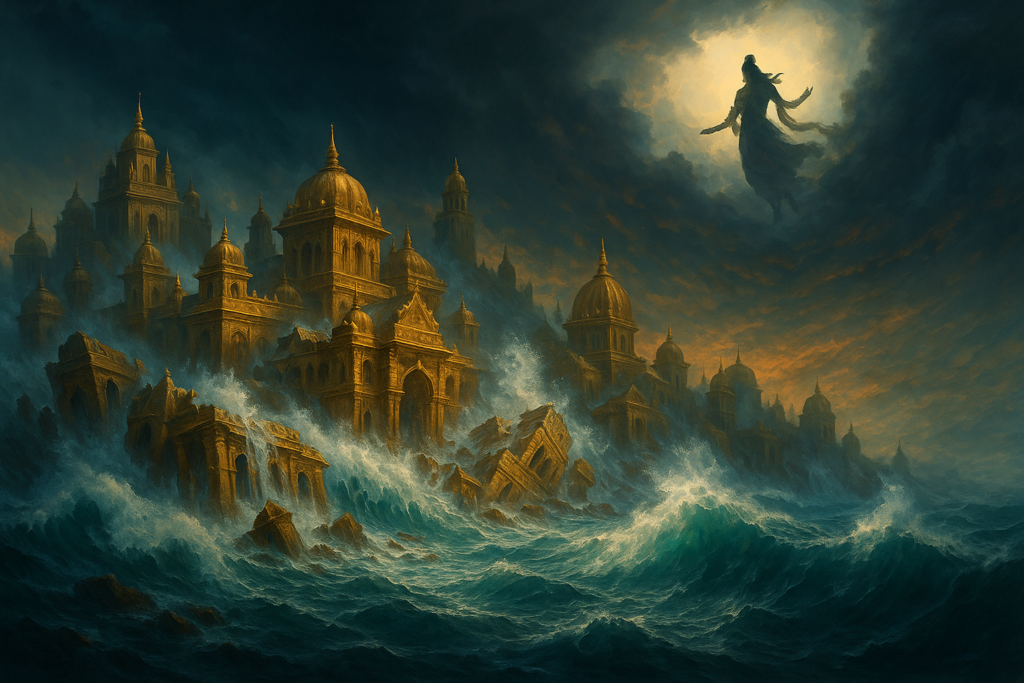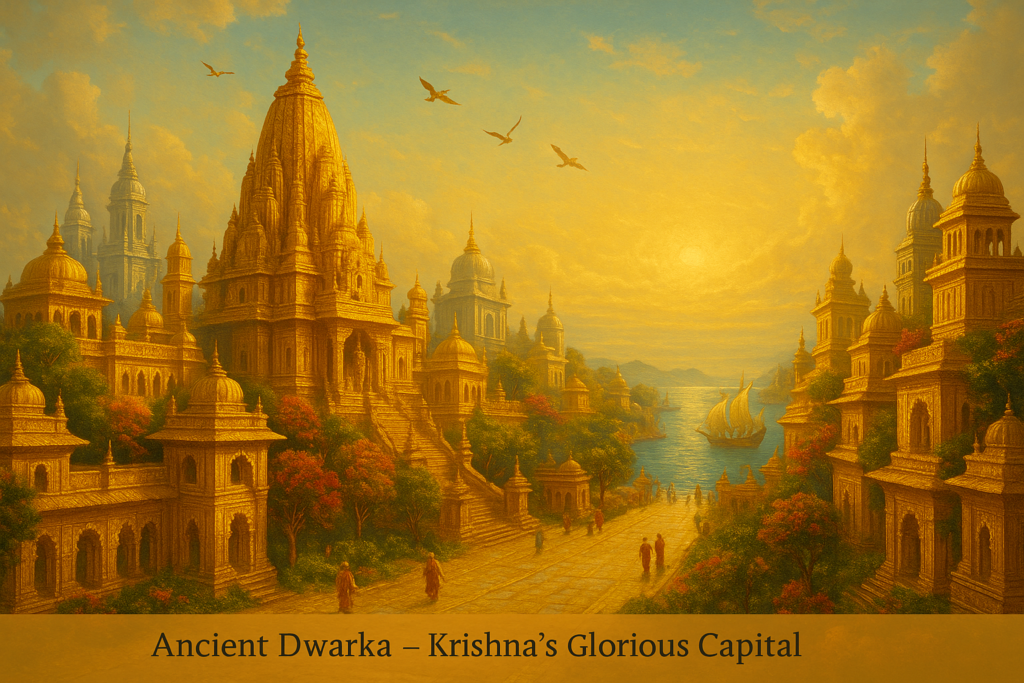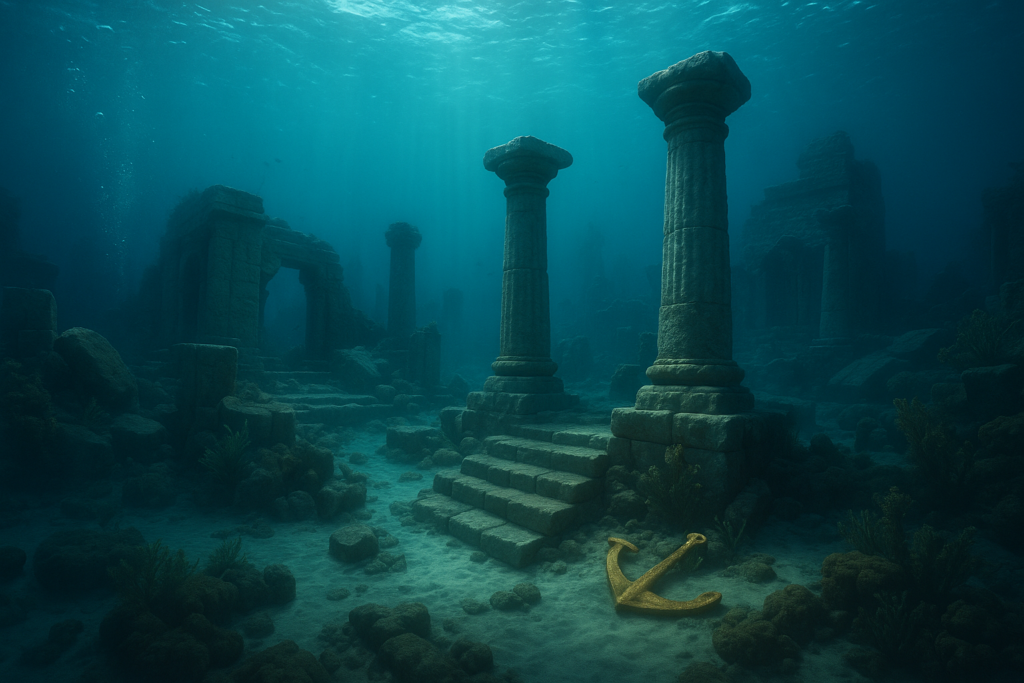Introduction
The Lost City of Dwarka isn’t just a myth carved in scripture — it’s a mystery that has stirred the imagination of believers, historians, and archaeologists alike. Said to have been founded by Lord Krishna himself and later engulfed by the Arabian Sea, Dwarka’s story dances on the edge of legend and reality. For centuries, it was dismissed as folklore — until deep beneath the coastal waters of Gujarat, ancient ruins whispered a different truth.
Could this sunken city be the Dwarka of the epics? Is there history buried beneath the waves? Let’s journey into India’s greatest underwater enigma — where mythology meets marine science, and memory meets the ocean.
Table of Contents
- The Myth of Dwarka: Krishna’s Sacred Kingdom
- The Lost City of Dwarka in Hindu Scripture
- Why Krishna Built Dwarka: A City of Purpose
- The Submergence: Prophecy and the Sea’s Claim
- Dwarka Today: The Sacred Pilgrimage Site
- Uncovering the Lost City of Dwarka Beneath the Sea
- What Science Says: Dating the Submerged Ruins
- Myth or History? A Debate Across Time
- Dwarka and the World: Other Sunken Civilizations
- Conclusion: Dwarka’s Eternal Message
- FAQ
- Resources & References
The Myth of Dwarka: Krishna’s Sacred Kingdom

Dwarka wasn’t born like ordinary cities. It was divinely constructed, say the Puranas — a fortress-city built for Dharma to thrive, and for Krishna to rule as both king and teacher.After countless assaults on Mathura by the tyrant Jarasandha, Krishna decided to move his people westward. With the blessings of Samudra Dev, the ocean god, land was reclaimed from the sea. And upon it rose Dwarka, a city like no other.
“The city shone like the capital of Indra. Its walls were built of silver, its gates of gold. Crystals paved the streets, and the breeze carried the scent of divine blossoms.”
— Harivamsa Purana
Its very name means “gateway” — a passage between the material and the divine.
The Lost City of Dwarka in Hindu Scripture
Dwarka is not a passing mention — it’s a central backdrop in the later chapters of Krishna’s life.
How Ancient Texts Described Krishna’s Dwarka
- In the Mahabharata, Krishna leaves Mathura and establishes Dwarka as his capital.
- The Mausala Parva describes its opulence and eventual destruction.
- The Bhagavata Purana dedicates multiple cantos to Krishna’s life in Dwarka, his marriages, his governance, and the city’s divine purpose.
- Other references appear in the Vishnu Purana, Skanda Purana, and Padma Purana.
“When Krishna departed for his divine abode, the sea swallowed Dwarka, and only the memory remained.”
— Bhagavata Purana, Canto 11
These consistent descriptions have preserved Dwarka’s memory for thousands of years.
Why Krishna Built Dwarka: A City of Purpose

Dwarka was more than a refuge. It was a spiritual blueprint.
- Strategically placed by the sea, it was protected from invasions.
- It reflected the ideal Vedic city: prosperous, disciplined, and dharmic.
- Krishna’s rule from Dwarka served as a lesson in righteous kingship, far removed from ego or conquest.
It became a living example of balance between artha (material prosperity) and dharma (righteousness).
The Submergence: Prophecy and the Sea’s Claim
The most haunting part of Dwarka’s tale is its foretold end.
As Krishna withdrew from earthly life, the city’s divine protection faded. Soon after his departure:
- The Yadava clan descended into civil strife.
- Krishna renounced his mortal form in Prabhas.
- The Arabian Sea rose, flooding Dwarka in waves.
“The ocean claimed what heaven once blessed.”
— Mahabharata, Mausala Parva
Whether metaphor or memory, the imagery is unforgettable.
Dwarka Today: The Sacred Pilgrimage Site
The present-day Dwarka in Gujarat remains a deeply sacred place.
- The Dwarkadhish Temple, dedicated to Krishna, is a Char Dham site.
- Gomti Ghat and Rukmini Temple are major attractions.
- The town’s legacy preserves a living connection to the epic age.
But is this the same city that once glowed with divine grandeur? Or merely a successor on the same sacred soil?
Uncovering the Lost City of Dwarka Beneath the Sea
In the 1980s and 2000s, marine archaeologists from NIO and ASI began their search.
What they found was astonishing:
- Submerged stone structures off the coast
- Urban grid layouts, harbor remnants
- Anchors, tools, and pottery dating back thousands of years
- Evidence of a once-prosperous port city
Some of these findings were even older than the Harappan sites.
“If verified, these could rewrite the history of urbanization in India.”
— ASI Report (2002)
What Science Says: Dating the Submerged Ruins

While the ruins are real, debates continue over their age:
- Radiocarbon dating suggests a range of 7500 BCE to 1500 BCE.
- Critics argue marine drift may affect context.
- Supporters believe this aligns with traditional timelines for Krishna’s era (~3100 BCE).
The presence of maritime infrastructure adds to the case that this was a major trading and cultural hub.
Myth or History? A Debate Across Time
The Skeptics:
- Say there is no direct inscriptional evidence
- Suggest structures could be natural formations
The Believers:
- Emphasize consistency of textual descriptions
- Cite oral traditions and precise alignments
In truth, Dwarka straddles the realm of both — symbolic truth and historical possibility.
Dwarka and the World: Other Sunken Civilizations
Dwarka is not alone:
- Heracleion and Canopus (Egypt)
- Port Royal (Jamaica)
- Yonaguni Monument (Japan)
These global parallels remind us that the sea has always held secrets — and that myth often preserves ancient memory.
Conclusion: Dwarka’s Eternal Message
Dwarka teaches us:
- Even divine cities are impermanent.
- History and mythology are not enemies — they are partners in truth.
- What is submerged may still shape the surface.
The Lost City of Dwarka remains a mystery. But it is also a message. A mirror held to civilization, reminding us that every age must end — and every story must echo.
FAQ
Q1: Was the Lost City of Dwarka real or mythical?
Scriptures and archaeology suggest it could be both: a real city with legendary significance.
Q2: Where is Dwarka located today?
Modern Dwarka is in Gujarat, India. It is a major pilgrimage site and possible continuation of the ancient city.
Q3: What caused Dwarka to sink?
Mythology cites divine will; science suggests rising sea levels or tectonic shifts.
Q4: Is there scientific proof that Krishna lived in Dwarka?
No definitive proof exists, but textual consistency and recent underwater finds support the possibility.Q5: Can tourists see the ruins of the Lost City of Dwarka?
They are underwater and accessible only to authorized research divers.
Resources & References
(No external links in body. Listed here for transparency and further reading.)
- Mahabharata, Mausala Parva (Critical Edition)
- Bhagavata Purana, Canto 10 & 11
- Harivamsa Purana
- Reports from NIO and ASI (2001–2010)
- Journal articles on underwater archaeology in the Gulf of Khambhat
- Media coverage: The Hindu, Indian Express archives (2000s)
- Graham Hancock’s documentary analysis
